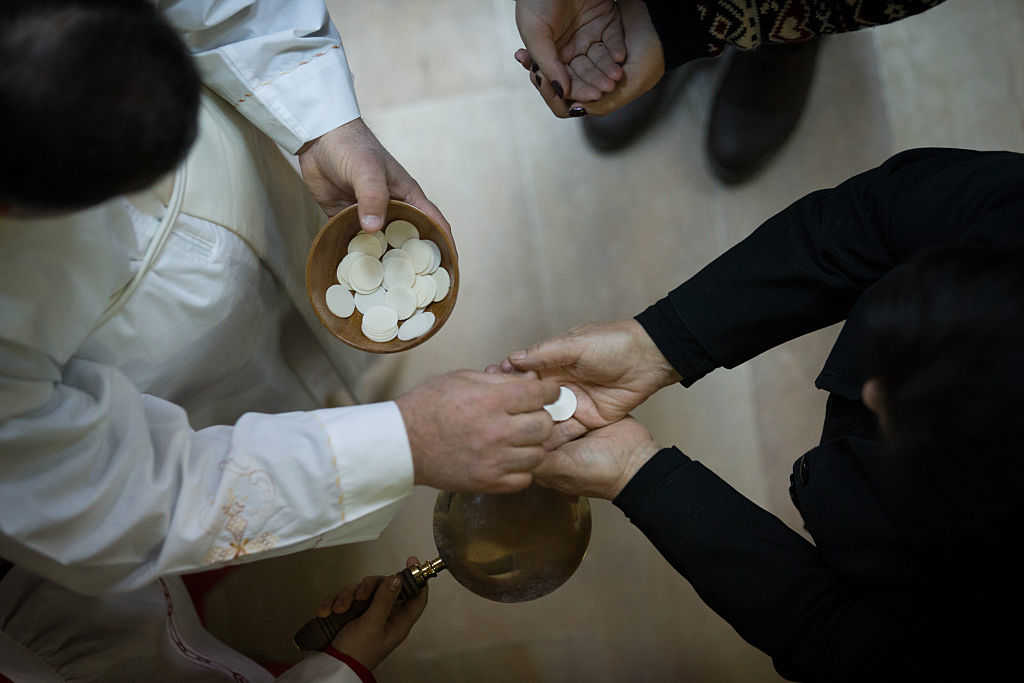In the Christian church, Communion is one of the most contested and debated topics. We group ourselves according to our beliefs on it – whether or not we take it on a regular schedule, whether we use wine or grape juice, wafers or bread and whether we believe in transubstantiation or not.
As someone who grew up staunchly Catholic, I understand why these debates cause such a stir.
To a Catholic, Holy Communion is Jesus’ real presence – His sacred Body and Blood. In the celebration of the Mass, it is THE main thing. Bells are rung when the bread and wine are blessed. Devout prayers are said and then each in-good-standing-Catholic-only person files up to the altar reverently to receive this holy meal. I received Holy Communion as often as I was able in my childhood and early adulthood.
Given my upbringing and reverence for the blessed sacrament of Holy Communion, you can imagine my consternation when I experienced the sacrament for the first time in a Protestant church. It was all much more casual.
After marrying my Protestant husband, we participated in a Lutheran church, and eventually, we landed in a laid-back church – an environment totally opposite of the liturgical Masses of my childhood. We met in a school and sat on folding chairs.
One Sunday, we were instructed to come up to the table, self-serve style and take a mini pre-filled cup, (like the creamers that restaurants put out in little bowls on your table), go back to our folding chairs to pray and then eat and drink individually when we were ready.
I did as I was told, wondering the whole time why we were receiving just wine but no bread.
“Budget cutbacks?” I speculated.
“Too many hands touching the wafers?” I wondered (since it was flu season and the H1N1 media frenzy was in full force).
I was supposed to be praying but, regretfully, these were the thoughts that filled my mind. The lights in the school auditorium were turned down for this reflective time so I put on my reading glasses so I could tear open the cup without spilling it. And there, on top of the cup, I found a mini wafer that I had not seen before. That teeny, tiny, itsy bitsy pre-packaged wafer was our bread.
I was mortified to experience the Holy Eucharist in such laissez-faire fashion.
Where was the blessing? Where was the holiness? I felt as though we just downgraded Jesus to a speedy, serve yourself, take-out, drive through meal.
“Take-Out Jesus,” I fumed. “What will they do next?”
Not long after this experience, I was reading Matthew’s account of the Last Supper in “The Message,” a contemporary translation of the Bible. In the notes of reflection on the passage, the author, Pastor Eugene Peterson, shared this sermon excerpt.
The focal event of Jesus’ work of salvation was sacrifice. The four verbs He used at the Last Supper put salvation into action every time we sit down to a meal. Notice the verbs in the text: “During the meal, Jesus took and blessed the bread, broke it and gave it to his disciples” (verse 26, emphasis added). The words are words of sacrifice. We deliberately set ourselves in God’s presence at the Lord’s Supper so that we might become like Jesus. Our lives, like his, are to be sacrificially lived – taken, blessed, broken and given to others.
“Take-Out Jesus.”
That’s exactly the verb Jesus used: TAKE. This is what we are supposed to do.
Take. Out. Jesus. Into the world.
Into everyday life. Into our workplace. Into our marriages, our homes, our friendships, our families. Jesus is meant to be shared.
He doesn’t really care if we do it via holy jewel encrusted chalices ensconced in incense or via homemade bread loaves or even in plastic to-go containers. He doesn’t care if the bread is gluten-free or chock full of gluten. He just wants to be shared, not saved up for special occasions, like fine china.
As always, the Holy Spirit redirected my thoughts. I’ve been slowly learning that it’s okay to carry Take-Out Jesus with me. In my heart, in my hands … everywhere I go. I’m learning how excruciatingly necessary and importantly portable He is in all areas of my life. Like the common stories He told when He walked this earth, He is indeed in teeny tiny mustard seeds and salt crystals and flecks of light and even creamer cups.
Andrea Syverson is the author of “Alter Girl: Walking Away From Religion Into the Heart of Faith,” releasing Sept. 5, in which she describes her personal faith journey in, around, and through the church on her way to a deeper connection to Jesus.


